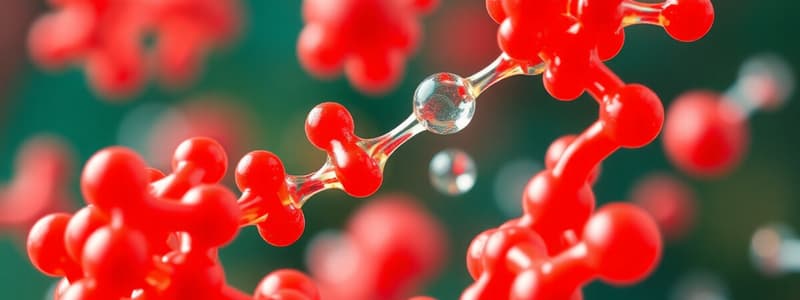Podcast
Questions and Answers
How do enzymes increase the rate of a chemical reaction?
How do enzymes increase the rate of a chemical reaction?
- By being consumed in the reaction.
- By raising the temperature of the reactants involved.
- By lowering the activation energy required for the reaction. (correct)
- By increasing the activation energy required for the reaction.
Why do extremes in pH eventually inactivate enzymes?
Why do extremes in pH eventually inactivate enzymes?
- Extremes of pH disrupt the active site's ability to bind substrate.
- Extremes of pH permanently alter the enzyme's structure. (correct)
- Extremes of pH directly consume the enzyme.
- Extremes of pH always boil the enzyme.
What is the most likely reason fresh pineapple cannot be used in gelatin-based products?
What is the most likely reason fresh pineapple cannot be used in gelatin-based products?
- Pineapple's high sugar content interferes with the gelatin's chemical structure.
- Acidity in pineapple prevents gelatin from solidifying.
- Bromelain in pineapple digests the proteins necessary for gelatin to set. (correct)
- The added liquid prevents gelatin from setting.
Which of the following best describes the induced-fit model of enzyme function?
Which of the following best describes the induced-fit model of enzyme function?
What is the primary difference between digestion and emulsification?
What is the primary difference between digestion and emulsification?
How does bile contribute to the digestion of fats?
How does bile contribute to the digestion of fats?
If a scientist increases the temperature of an enzyme-catalyzed reaction beyond the enzyme's thermal optimum, what is most likely to happen?
If a scientist increases the temperature of an enzyme-catalyzed reaction beyond the enzyme's thermal optimum, what is most likely to happen?
Which of the following statements accurately describes the role of the active site in an enzyme-catalyzed reaction?
Which of the following statements accurately describes the role of the active site in an enzyme-catalyzed reaction?
How does chilling food prevent spoilage and hinder bacterial growth?
How does chilling food prevent spoilage and hinder bacterial growth?
If a mutation causes a change in the amino acid sequence of an enzyme far from its active site, what is the most likely outcome?
If a mutation causes a change in the amino acid sequence of an enzyme far from its active site, what is the most likely outcome?
Flashcards
What are enzymes?
What are enzymes?
Substances that speed up chemical reactions without being consumed
Activation energy
Activation energy
The energy required to start a chemical reaction, which enzymes lower.
Thermal Optimum
Thermal Optimum
The specific temperature at which an enzyme functions most effectively.
Enzyme Denaturation
Enzyme Denaturation
Signup and view all the flashcards
Active Site
Active Site
Signup and view all the flashcards
Emulsification
Emulsification
Signup and view all the flashcards
What is Casein?
What is Casein?
Signup and view all the flashcards
Hydrolysis
Hydrolysis
Signup and view all the flashcards
Lypolysis
Lypolysis
Signup and view all the flashcards
Study Notes
- Enzymes are biological catalysts that speed up chemical reactions without being used up.
- They lower the activation energy needed for a reaction to proceed.
Activation Energy
- Activation energy is the "energy barrier" that must be overcome for a reaction to proceed.
- A catalyst or enzyme lowers the activation energy.
- Reactions occur more readily with a catalyst or enzyme.
Reactions and Enzymes
- Reactants are converted into products.
- Enzymes speed up the reaction.
Enzyme Characteristics
- Enzymes are usually globular proteins.
- They are highly specific to the reactions they catalyze.
- Each enzyme has a thermal and pH optimum for activity.
- Temperatures above the optimum can denature the enzyme by changing its tertiary structure.
- High temperature changes can cause irreversible denaturation.
- Lower temperatures reduce the reaction rate.
- Non-optimal pH values can also inactivate enzymes.
- Certain poisons can block enzyme function.
Examples of Enzyme Activity
- Pepsin is an enzyme that works best in acidic pH.
- Pancreatic lipase works best in a slightly alkaline pH.
- Frog and human enzymes have thermal optima around 30-40°C.
Historical Context and Importance
- Enzymes were first recognized in the 19th century.
- The term "enzyme" comes from the Greek word meaning "in yeast."
- Even simple bacteria have over 1,000 enzymes, with more complex organisms having even more.
Enzymes in Practical Applications
- Enzymes can be used outside of living organisms.
- Meat tenderizers contain papain, which pre-digests proteins.
- Fresh pineapple contains bromelain, which can affect the tongue and prevent gelatin from setting.
- Enzymes are also used in laundry detergents to break down protein-based stains.
- Historically, enzymes have been used in processes like wine and cheese production.
Induced-Fit Model
- The induced-fit model describes an enzyme-catalyzed reaction.
- Enzymes and substrates undergo dynamic modifications during the transition state in the active site.
- The enzyme itself is not destroyed or changed during the reaction.
- Enzyme names often correspond to the substrate and end in "-ase."
Cheese Making
- Cheese making involves separating the solid portion (curd) from the liquid (whey).
- The curd is primarily casein, a protein.
- Two types of cheese: sour-milk and rennet cheese.
Cheese Production Steps
- COAGULATION: Letting the milk sit
- CUTTING: Cut mixture up and let it sit
- HEATING: Heat to 100-102 degrees
- DRAINING: Separate the curd from the whey
- STIRRING: Keep stirring until mixture gets hard
- SALTING: Use salt as natural preservation
- PRESSING: Removing any excess fluid
- AGING: Letting the cheese age and develop unique flavor
Bile and Fat Digestion Experiment
- The experiment investigates milk fat digestion by pancreatic lipase and the role of bile.
- Lipase, secreted by the pancreas, catalyzes the hydrolysis of triglycerides into fatty acids and glycerol.
- Bile, secreted by the liver, emulsifies fats, breaking large droplets into smaller ones.
- Emulsification increases the surface area for lipase to act on.
Procedure of Bile and Fat Digestion Experiment
- Use litmus "PH" is blue in Alkaline/Red in Acidic.
- Several tubes, each in different environments
- Mix it all + add lipase last
- Leave for 1 hour then record
Key Concepts in the Experiment
- Lipase breaks down fat into fatty acids.
- Bile aids in emulsification, but isn't an acid.
- Fatty acids are components of broken down fat
Additional notes on the experiment
- Once the bile was added it caused pH to change.
- Lipase helps function in the Pancreas where the pH is 7
- It digested greater when litmus cream PH was adjusted to 8
- Digestion is breaking down simpler while Emulsification is using digestion
- Lipolysis is breaking down fat into component parts
Cheese Making and Enzyme Characteristics
- Enzymes are usually globular proteins.
- Not all enzymes are catalysts, and vise versa.
- Active sight is the region on enzyme that fits substrate.
- The process of breaking a polymer down into monomers using water is called hydrolisis
- The process of breaking fat down into smaller components is lipolysis
Studying That Suits You
Use AI to generate personalized quizzes and flashcards to suit your learning preferences.




